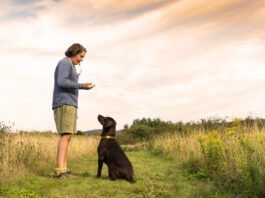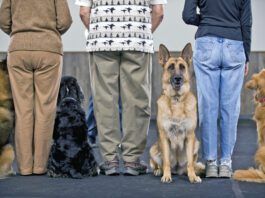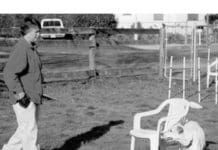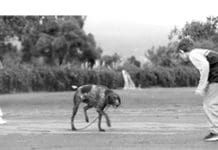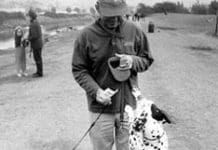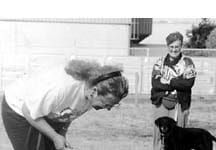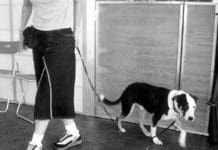Off Leash Training: Building Reliability
There is no way to guarantee the safety of your dog off leash. I would like to think that if we trained hard enough, or long enough, or with the right methods, that we could overcome all of the risks, that our dogs really could be completely reliable and safe. But the fact is that when dogs are off leash in an unsecured area, there will always be a chance that their instincts or desires will lead them into the path of danger. In addition, our environment is often unpredictable. When dogs are off leash, there is the chance of a sudden bang, an unexpected animal, or something else that may frighten or harm our dogs.
Training Your Dog to Behave Around Guests
Whether you have a pup with normal puppy energy or an obstreperous teenager who has good manners lessons to catch up on, clicker training can be a magically effective and gentle way to convince a dog to calm down. No yelling, no physical punishment; just clicks and treats for any pause in the action. That said, the biggest challenge with a hyper" dog is that any praise or reward may cause her to begin bouncing off the walls again. It is nearly impossible to deliver a treat to an excitable dog while she is still in the act of being calm. By the time you get the treat to her mouth she is once again doing her Tasmanian devil act."
Force-Based Training Methods and Some Unintended Consequences
Most people, unwittingly or intentionally, use a lot of physical force when raising and training their dogs. The purposeful ones have a whole variety of reasons. Some may have read about behavioral theories regarding dominance and “the importance of showing the dog who’s boss.” Fans of these theories may advocate imitations of canine behavior such as “scruff shakes” or “Alpha rolls” to convince the dog he’s at the bottom of the family hierarchy. Others may have been influenced by advocates of traditional, military-style training – think of yanking collar ‘corrections’ or using the leash leveraged under their foot to forcibly pull a dog into a Down.
Teaching Your Dog “Off”
When they fill out their evaluation forms at the end of a six-week course, my clients frequently name the Off" exercise as one of the most useful behaviors they have taught their dogs in class. "Off" means "Whatever you are paying attention to right now
Getting Your Children Involved in Training the Family Dog
One of the things that parents almost always say when they decide to add a dog to the family is, It will help teach the kids about responsibility." That's the hope
How to Teach Your Dog to Eliminate on Cue
and will be forced to soil the crate. Once a puppy's inborn instinct to keep his "den" clean is broken
How to Stop Lunging Behavior
My nine-month-old Bouvier puppy is in training, but I am having trouble finding a positive way to stop his lunging; he is very strong. I am using a choke chain, and my current trainer feels I'm not firm enough in my corrections. I don't feel comfortable using the choker, but also don't like the idea of the Halti because it might be even more dangerous if he lunged.
A Guide to Choosing the Best Dog Trainer for You AND Your Dog
So, you’ve decided that you and your dog need professional help. Don’t worry; all relationships can use a helping hand at one point or another. Maybe the two of you have communication issues that need to be dealt with (like your dog doesn’t listen and you wish he would!). Or maybe your bouncing bundle of fur is growing faster and bigger than expected, and you’re desperate for a constructive outlet for all that energy and enthusiasm. You’re sure that training is the answer to your problems – and you are probably right!
Classical Conditioning for Dogs
Classical conditioning, quite simply, is learning by association. It is when a person or animal associates one stimulus with something that was not previously associated.
Best Dog Training Approaches
All dog training techniques fit somewhere on a long continuum, from seriously harsh and abusive punishment-based methods at one extreme, to pure positive reinforcement at the other. Neither extreme is likely to be very practical or effective, nor will you find many trainers who recommend using only methods from one end or the other. Most trainers use a combination of techniques that place them somewhere between the two ends of the continuum. Which side of center they are on defines them as primarily compulsion-based trainers or primarily positive ones.
Properly Crate Training Your Dog
Crates are perhaps second only to choke collars as the most misused training equipment forced upon dogs. However, unlike choke collars, there is a terrific training principle behind the use of crates. A crate, or, in other words, short-term close confinement, can be used to help dogs teach themselves two very important skills. The first is eliminating only when and where it is appropriate. The second skill is keeping out of trouble behaving appropriately in the house. Without these two skills, a dog doesn't have much of a chance in this world.
Training Other Species to Become a Better Dog Trainer
Training chickens? What an odd idea! Yet all across the country, animal owners and trainers are flocking to workshops put on by a legendary husband-and-wife team, learning how to train chickens . . . so that they may better train their dogs. Here’s my account of one such workshop, held recently in Monterey, California. It was 9 a.m., on a cool, cloudy morning in late September. Twenty-two dog trainers, hailing from all over California (and one from Illinois), were perched on the edges of our chairs, waiting with nervous anticipation for the workshop to begin.



